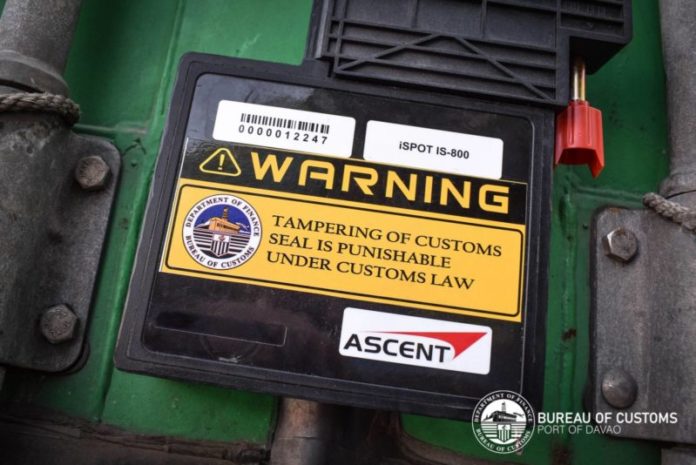
-
The E-TRACC System for customs bonded warehouses’ imports and exports is being fully implemented from today, July 25, at the Manila International Container Port and Port of Manila
-
Assessment and Operations Coordinating Group Memo No. 230-2022 provides guidelines for full implementation of Electronic Tracking of Containerized Cargo for CBW imports and exports at the two collection districts
The Electronic Tracking of Containerized Cargo (E-TRACC) System for customs bonded warehouses’ imports and exports is in effect at Manila ports starting today (July 25).
Bureau of Customs (BOC) Assessment and Operations Coordinating Group (AOCG) Memo No. 230-2022 dated July 14 and signed by AOCG deputy commissioner Edward James Dy Buco provided the guidelines for 100% implementation of the E-TRACC System for all CBW imports and exports at the Manila International Container Port (MICP) and Port of Manila (POM).
All concerned offices were directed to ensure all containers they process adhere to Customs Memorandum Order No. 04-2020, which implements the E-TRACC System, and the specific guidelines provided in AOCG Memo 230-2022.
Moreover, AOCG Memo 230-2022 noted that BOC examiners/appraisers or any authorized customs officers responsible for processing import or export clearance will not approve any import or export single administrative document without the required E-TRACC booking as prescribed under CMO 04-2020.
For CBW imports, the transfer of full container load (FCL) should require an electronic customs seal (ECS) before leaving the container yard at the port of discharge.
The ECS is a GPS-enabled sealing device or lock that is capable of securing a container and providing real-time location information.
The AOCG memo said transfers of loose cargo load (LCL), meanwhile, should follow current rules and regulations and still be underguarded by the warehouseman and/or customs guard to the client member warehouse/sub-contractors. This will be followed by an urgent need to disarm the ECS and to strip the container.
For CBW imports to miscellaneous bonded warehouses, FCL containers should be sealed with an ECS and therefore will not need underguarding. The steps to unseal the ECS at the destination will be performed by the warehouseman or customs guard.
For CBW imports to common bonded warehouses, FCL containers bound from the port to the mother warehouse and to client member warehouse should also be sealed with an ECS.
In case of FCLs for garments, the warehouseman/guard, upon arrival of container at the mother bonded warehouse, will do the unsealing.
For an FCL container bound for a miscellaneous bonded warehouse, the warehouseman should undertake visual evidence of the container upon its arrival at the mother bonded warehouse, and check if the ECS and the container seal of the shipping line are still intact.
After inspection, the truck carrying the FCL should then proceed to the member CBW, and the security guard assigned at the member CBW will again take visual evidence and transmit information to the concerned BOC office. The customs warehouseman/guard should then remove the ECS from the container once BOC authorized “end trip”.
For CBW exports, FCL and LCL containers for export should also be sealed with an ECS before their transfer to the port of loading.
FCL containers sealed with ECS from the CBW bound to the port of loading will no longer need underguarding.
Arming/affixing the ECS should be undertaken by the assigned customs warehouseman, while unsealing or disarming of the ECS at the port will be done by Customs Container Control Division personnel.
E-TRACC is a Web-based system launched in 2020 to track the inland movement of containerized cargoes during transit and transfer to other customs territories and facilities. It allows BOC to track, monitor, and audit the location and condition of cargoes, as well as obtain real-time alarms on diversion and tampering of cargoes.
Several memos have been issued since 2020 on the gradual inclusion into the system of various economic zones, freeports, and collection districts, and for imports, inter-island shipments, and CBWs. BOC has also held public consultations on the proposed implementation of E-TRACC in all airports of entry.
Under CMO 04-2020, an ECS is required during the transfer of cargo to a container yard/container freight station or other customs facilities and warehouses; transit of cargo bound for free zones, inland customs offices, depots, or terminals; transit to CBWs; export of cargo from free zones, inland customs offices, depots or terminals, and CBWs to port of loading; and transfer of shipments subject to further verification or monitoring.
All container vans covered by CMO 04-2020 should be affixed with an ECS before being cleared to depart from the starting point or point of discharge for the voyage to the end point or point of destination.
Except when warranted under CMO 04-2020, customs cargo clearance must be fully completed before any shipment can be sealed with an ECS. – Roumina Pablo




